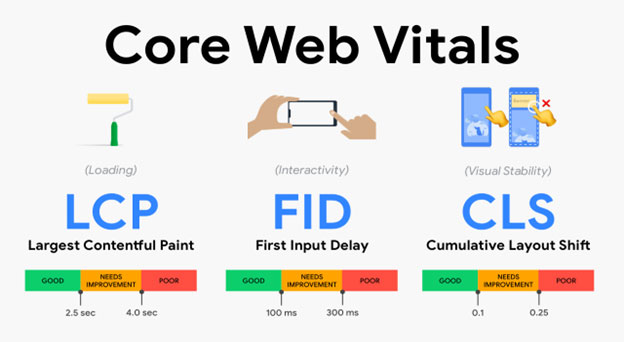
In today’s digital world, it became very important for businesses to provide a positive user experience on their websites. As the use of mobile devices and the internet is increasing, consumers expect fast-loading, responsive websites. To cater to these expectations of consumers, businesses are focusing on improving the performance of their websites and the most effective way to do this is by monitoring and optimizing the Core Web Vitals of the website.
Core Web Vitals are a set of metrics that measure the loading performance, interactivity, and visual stability of a website. These metrics play an important role in identifying potential performance bottlenecks that may be impacting user engagement.
In this blog post, we will talk about Core Web Vitals and how they can be used to improve the performance of a website. We will talk about the impact of Core Web Vitals in the digital marketing field.
First, we will have a look at the important aspects of Core Web Vitals.
Core Web Vitals Metrics
1. Largest Contentful Paint (LCP): loading performance of a page is measured by this metric.
2. First Input Delay (FID): The interactivity of a page is measured by this metric.
3. Cumulative Layout Shift (CLS): All the layout shifts that occur across a webpage are measured by this metric.

Source: https://akshayranganath.github.io/Understanding-And-Using-Core-Web-Vitals/
Core Web Vital in Digital Advertising
As these metrics provide a holistic view of the user experience on a website they are becoming increasingly important in Digital marketing.
The Core Web Vitals can be used to measure the performance of landing pages and other web pages that are part of an advertising campaign. By improving the performance of these pages, brands can increase the effectiveness of their advertising campaigns.
Poor performance of a webpage can lead to increased bounce rates and decreased conversions. By monitoring and improving the Core Web Vitals, brands can ensure that their websites are providing a positive user experience, which can lead to increased engagement and conversions.
Improvement in the core web vitals improves the overall user experience, resulting in better ROI of the marketing investments. It can also help to improve the SEO by making the website more performant and faster, which is one of the factors that search engines consider when ranking websites.
How Core Web Vitals improve Digital Advertising performance
Here are a few ways in which they are being used:
Targeting: By monitoring and analyzing the Core Web Vitals, brands can identify specific areas of their websites that are causing performance issues. This information can then be used to target specific areas of the website for optimization, such as reducing the number of page elements or optimizing images and videos.
Personalization: Brands can use Core Web Vitals to personalize the user experience based on the user’s device, browser, or network conditions. By understanding how different devices, browsers, and network conditions affect website performance, brands can optimize the website for specific user segments and improve the overall experience for those users.
Optimization: By monitoring and analyzing the Core Web Vitals, brands can optimize the website for better performance, such as reducing load times, improving interactivity, and increasing visual stability. This can lead to a better overall user experience, which can result in increased engagement and conversions.
Core Web Vitals are being used for targeting, personalization, and optimization, and have a positive impact on consumer behavior and corporate marketing activities by providing a better user experience, increasing engagement and conversions, and improving the ROI of marketing investments.

Source: https://instapage.com/blog/google-accelerated-mobile-pages
Core Web Vitals Evolution and Effect on Digital Marketing
From my point of view, the trend of core web vitals will continue to evolve and become increasingly important in the future of digital marketing.
As more and more businesses shift towards online and mobile channels for their marketing efforts, the user experience on their websites and mobile apps will become even more critical. Brands will need to focus more on core web vitals and ensure that their websites are providing a positive user experience.
The use of Artificial Intelligence (AI) and Machine Learning (ML) algorithms to analyze and optimize website performance will become more prevalent. This will allow brands to continuously monitor and optimize their core web vitals, which will help them to provide a better user experience for their customers.
Additionally, in the future, search engines will continue to place more emphasis on the importance of core web vitals. This means that brands that have high-performing websites will have an advantage in search engine rankings.
An Example:
Amazon has implemented an open-source project named AMP (Accelerated Mobile Pages) that aims to improve the performance of mobile web pages by reducing the amount of code and resources required to load a page. By implementing AMP, Amazon has been able to reduce the load time of its mobile pages, which has led to a better user experience and increased conversions.

Source: https://instapage.com/blog/google-accelerated-mobile-pages
AMP implementation has led to a 20% increase in conversions on mobile devices and a 15% reduction in bounce rates on mobile pages.
In terms of ROI, Amazon has seen a significant increase in revenue because of its AMP program. Amazon has been able to increase conversions and reduce bounce rates, which has led to an increase in revenue. The exact ROI of the campaign is not publicly available, but the performance statistics show that the implementation of AMP has been a success for Amazon.

